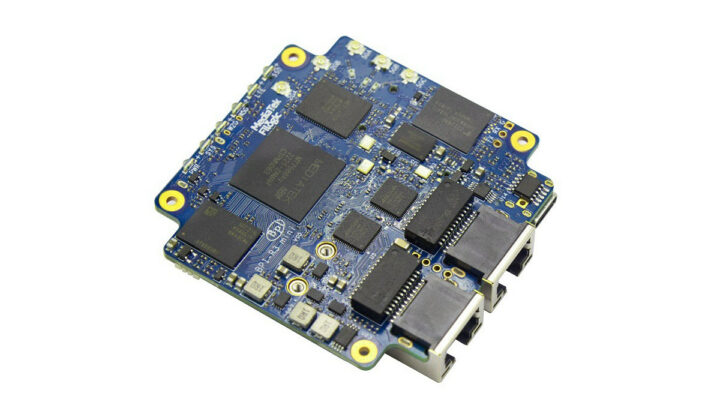Banana Pi BPI-R3 Mini router board is powered by MediaTek MT7986 (Filogic 830) quad-core Arm Cortex-A53 processor with 2GB DDR4, an 8GB eMMC flash, two low-profile 2.5GbE ports, and WiFi 6 support. It also comes with an M.2 PCIe socket that can be used with an NVMe SSD or a 5G cellular module.
The BPI-R3 Mini is based on many of the same chips as found on the Banana Pi BPI-R3 board, but with a much more compact design that makes it suitable as a 2.5GbE firewall, wireless router or repeater, home security gateway, home automation gateway, NAS device, and more.
Banana Pi BPI-R3 Mini specifications:
- SoC – MediaTek MT7986A (Filogic 830) quad-core Arm Cortex-A53 processor with hardware acceleration engines for Wi-Fi offloading and networking
- System Memory – 2GB DDR4 RAM
- Storage – 8GB eMMC flash, 128MB NAND flash, M.2 2230 NVMe SSD socket
- Networking
- 2x 2.5GbE RJ45 ports via Airoha EN8811H controllers
- Dual-band WiFi 6 via MediaTek MT7976C (2.4GHz: 574Mbps + 5GHz: 2402Mbps) and 3x U.FL antenna connectors; note: some part of the specs also list MT7975N/MT7975P, but that does not seem right…
- Optional 5G connectivity via M.2 socket & Nano SIM port
- USB – 1x USB 2.0 Type-A port
- Expansion
- M.2 Key-B 3052 socket with USB 3.0 for 5G NR module
- M.2 Key-M socket (2-lane PCIe 2.0) for NVME SSD
- Debugging – 3-pin Debug UART header (3.3V) for serial console
- Misc – 6x LEDs, fan header, NAND/eMMC boot switch, Reset button,
- Power Supply – 12V/1.67A DC via USB-C “PD” port (I have the feeling it’s actually a 12V-only port)
- Dimensions – Small
- Weight – 100 grams
While the larger Banana Pi BPI-R3 router board has got OpenWrt 21.02, Ubuntu 22.04, and Debian 10/11 images, the Banana Pi BPI-R3 Mini router’s wiki only lists two OpenWrt images at this time, one with open-source drivers, and the other with closed-source MediaTek drivers. The source code for the OpenWrt 21.02 fork, which happens to contain binary firmware files for the EN8811H 2.5 Gbps Ethernet controllers can be found on GitHub.
The BPI-R3 Mini router goes for $78.94 plus shipping on Aliexpress. For reference, the full-featured Banana Pi BPI-R3 board sells for around $92 plus shipping, so the price difference is not that great, but the Mini version is still quite interesting since it packs so many features into a tiny form factor. Users wary of software support on Banana Pi boards may consider the Rockchip RK3568-based NanoPi R5S router instead, still with dual 2.5GbE networking and NVMe SSD support, but note that WiFi and 5G can only be added via USB 3.0 dongles.

Update: This article was initially published on March 14, 2023, and updated following the publication of further documentation and availability on Aliexpress.

Jean-Luc started CNX Software in 2010 as a part-time endeavor, before quitting his job as a software engineering manager, and starting to write daily news, and reviews full time later in 2011.
Support CNX Software! Donate via cryptocurrencies, become a Patron on Patreon, or purchase goods on Amazon or Aliexpress






